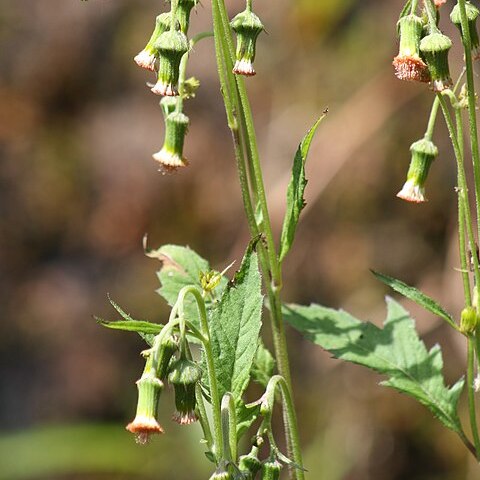Herbs, perennial, robust. Stems procumbent in lower part, erect above, green or purplish, 150-300 cm tall, 1.5-2 cm in diam., fleshy, woody at base, much corymbosely branched, conspicuously canaliculate, glabrous or ± hairy in upper part. Leaves large, sessile or shortly petiolate; blade abaxially sometimes becoming purplish, adaxially green, obovate, oblong-elliptic, elliptic, or oblong-lanceolate, (5-)10-30 × 4-11 cm, both surfaces glabrous, lateral veins 12-30-paired, base cuneately attenuate into short petiole or sessile with expanded semiamplexicaul broad auricle, margin irregularly sharply serrate, mucronulate, apex acuminate. Upper leaves smaller, oblong-lanceolate or lanceolate, apex long acuminate or caudate-acute. Capitula 10-12 mm in diam., usually 4-15 in terminal corymbose panicles; synflorescence branches unequal; peduncles 1.5-3 cm, slender, with 2 or 3 filiform-linear bracts, shortly pubescent. Involucres narrowly campanulate or cylindric, 12-17 × 8-12 mm; bracts of calyculus 7-9, linear-filiform; phyllaries 13-15, linear or linear-lanceolate, 13-15 × 1-1.5 mm, glabrous or subglabrous, conspicuously 3-ribbed, margin scarious, apically acuminate. Florets ca. 50; corolla orange, 11-13 mm; tube 7-9 mm, slender, dilated in upper part. Achenes brownish, 4-4.5 mm, puberulent, 10-ribbed. Pappus hairs numerous, white, 10-15 mm, silky, easily deciduous. Fl. Sep-Oct.
More
A herb. It keeps growing from year to year. The stems are robust and the lower parts can lie along the ground. They are green or purple and 1.5-3.0 m tall. The stems are up to 2 cm across. They are fleshy but woody at the base. The leaves are large and without leaf stalks. They can be purplish underneath. The leaves are broadly oval and 10-30 cm long by 4-11 cm wide. The leaves higher up are smaller.

